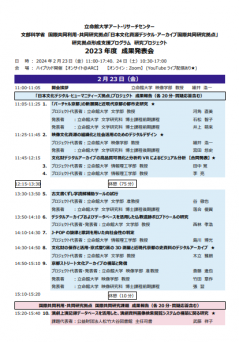-
 With the establishment of the International Joint Digital Archiving Center for Japanese Art and Culture (ARC-iJAC) in 2019, the Art Research Center strives to push the internationalization of research activities that transcend disciplines and geographic boundaries.
With the establishment of the International Joint Digital Archiving Center for Japanese Art and Culture (ARC-iJAC) in 2019, the Art Research Center strives to push the internationalization of research activities that transcend disciplines and geographic boundaries.NEWS


April 10, 2024: The cherry blossoms in front of the Art Research Center (ARC) at Kinugasa Campus, Ritsumeikan University, have reached their peak. 
 The Digital Archiving Workshop comes after the renewal of the MoU between Ritsumeikan University, Ritsumeikan Asia Pacific University, and SOAS University of London, which includes expanding research cooperation in Digital Humanities (DH).
The Digital Archiving Workshop comes after the renewal of the MoU between Ritsumeikan University, Ritsumeikan Asia Pacific University, and SOAS University of London, which includes expanding research cooperation in Digital Humanities (DH).
The workshop comprised of a talk by Prof. Ryo Akama (Director of the ARC) on the ARC Research Space as a comprehensive digital resesarch space for Japanese arts and culture, and a case study by Dr. Ellis Tinios (Honorary Lecturer, University of Leeds) on transforming research in old Japanese books through the ARC Research Space, followed by a practical session on digitization methods for Japanese materials based on ukiyo-e prints and old Japanese books in the SOAS Library collection. >> Read more.

 During the course of the ARC-iJAC project of Dr. Pilar Cabañas and her team of the Asia Research Group (GIA) at the Complutense University of Madrid in the past two years, significant progress has been made in the analysis and cataloging of ukiyo-e albums and illustrated books in the Complutense University Library collection.
During the course of the ARC-iJAC project of Dr. Pilar Cabañas and her team of the Asia Research Group (GIA) at the Complutense University of Madrid in the past two years, significant progress has been made in the analysis and cataloging of ukiyo-e albums and illustrated books in the Complutense University Library collection.
>> Read interview.
 The workshop, co-organized by the ARC-iJAC and the Research Center for Chinese Cultural Metaverse in Taiwan (CCMTW), National Chengchi University, in cooperation with the Department of History, Hong Kong Baptist University, was attended by Prof. Shi-Chi Mike Lan (Deputy Director of the CCMTW), Prof. Chi Man Kwong (Hong Kong Baptist University), and Prof. Keiji Yano (Deputy Director of the ARC), amongst others.
The workshop, co-organized by the ARC-iJAC and the Research Center for Chinese Cultural Metaverse in Taiwan (CCMTW), National Chengchi University, in cooperation with the Department of History, Hong Kong Baptist University, was attended by Prof. Shi-Chi Mike Lan (Deputy Director of the CCMTW), Prof. Chi Man Kwong (Hong Kong Baptist University), and Prof. Keiji Yano (Deputy Director of the ARC), amongst others.
Besides discussing the future collaboration between the ARC and the CCMTW, the workshop provided a valuable opportunity for an exchange opinions on various topics regarding the use of the metaverse in DH research, including platforms suited for research use, methods for acquiring high-quality 3D data, and the application of digital technologies, such as Geographic Information System (GIS), to the metaverse. >> Read more.The 13th Forum for Knowledge, Arts, and Culture in Digital Humanities was held by the Forum for Knowledge, Arts, and Culture in Digital Humanities, co-organized by the Kansai Division of the Japan Art Documentation Society and the Kansai Division of the Japan Society of Information and Knowledge in cooperation with the ARC-iJAC. This event also served as a conference for young researchers of the ARC-iJAC. >> Read more.Video on demand! 130. International ARC SeminarCo-hosted by the Art Research Center (ARC); SOAS Centre for Translation Studies; the Japan Research Centre (JRC), SOAS University of London; and Ritsumeikan Center for Game Studies (RCGS).1. Speaker: Dr. Ali ALAVI (Lecturer in Middle Eastern and Iranian Studies, School of Languages, Cultures and Linguistics & Co-Director of Centre for Iranian Studies, SOAS University of London)
Topic: Beyond Orientalism: The Evolution of Game Studies in Iran's Digital Realm
2. Speaker: Juhyung SHIN (Senior Researcher, Kinugasa Research Organization, Ritsumeikan University)
Topic: Exploring Serious Games in South Korea Upcoming Events
Upcoming Events
May 8 (Wed), 2024
132. International ARC SeminarCo-hosted by the Art Research Center (ARC); the Japan Research Centre (JRC), SOAS University of London; and SOAS Centre for Translation Studies.
1. Speaker: Dr. Monika HINKEL (Lecturer in the Arts of Japan, Department of History of Art and Archaeology, SOAS University of London)
Topic: Contemporary Interpretations of Ukiyo-e
2. Speaker: Prof. Yumi TAKENAKA (Graduate School of Core Ethics and Frontier Sciences, Ritsumeikan University)
Topic:「浮世としての家庭空間─勝川春章《婦女風俗十二ヶ月図》の構図をめぐる試論」
(Domestic Space as an Ukiyo: An Essay on the Composition of Katsukawa Shunshō's "Scenes of Women's Lives in the Twelve Months")
Participation: online via Zoom, free of charge
(relevant parties only, no reservation required)
*This is a closed event and YouTube livestream is not available.


Previous issues:
Winter 2023, Autumn 2023, Summer 2023, Spring 2023, Winter 2022, Autumn 2022, Summer 2022, Spring 2022, Winter 2021, Autumn 2021, Summer 2021, Spring 2021, Winter 2020, Autumn 2020, Summer 2020, Spring 2020[イベント情報]2024年4月17日(水)Background:
The ARC-iJAC project Ukiyo-e, illustrated books, albums and painted books in Madrid Collections emerged as an initiative of Asia Research Group (GIA), attached to the Complutense University of Madrid in Spain, which has been collaborating with the Art Research Center (ARC) for about two years and thanks to which significant progress has been made in the analysis and cataloging of ukiyo-e albums and books that are part of the collections of the Complutense University Library and that have remained almost unknown and, in some cases, in a poor state of preservation.
Involved in this project have been the professors Pilar Cabañas, Matilde Arias, Aitana Merino, and Ana Trujillo with the new incorporation of the researcher Alba Finol.
Click here for the Japanese collection of the UCM:
→ARC Ukiyo-e Portal Database
→ARC Early Japanese Books Portal DatabaseCould you please tell us about your motivation and the purpose of conducting the ARC-iJAC research project on the ukiyo-e, illustrated books, and albums in Madrid collections?
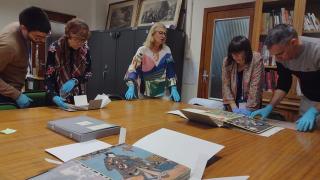
Cabañas: What encouraged us to initiate this project was to give value to the collections of the Complutense Library. Due to a lack of resources, these books and ukiyo-e had remained uncatalogued in the university's collections.
This project has enabled us to study them in-depth and make them known, not only in the Spanish context as part of the heritage of our institution, but also internationally, since the ARC database is a platform of great diffusion for specialists in Japanese art from all over the world. We are delighted with this possibility. Moreover, thanks to this collaboration, being in a space of great specialists, we can compare our knowledge and expand it.
[イベント情報]2024年4月 9日(火)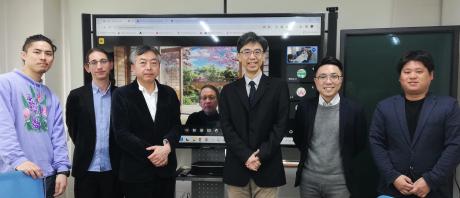
2024年3月25日に、国際ワークショップ「Practices and Challenges of Integrating GIS, VR, Metaverse in Digital Humanities Research」を、Research Center for Chinese Cultural Metaverse in Taiwan (CCMTW), National Chengchi University(以下、CCMTW)、立命館大学アート・リサーチセンター(以下、ARC) 国際共同利用・共同研究拠点(ARC-iJAC)の共催、Department of History, Hong Kong Baptist Universityの協力により実施しました。
本ワークショップは、オンラインとオンサイト(会場はARC)のハイブリットで開催しました。Shi-Chi Mike Lan 准教授(CCMTW)とChi Man Kwong准教授(Hong Kong Baptist University)が来日され、ARC会場にてワークショップに参加いただきました。
本ワークショップでは、CCMTWから3件、ARCから6件(うち3件はショートプレゼンテーション)の発表がありました。
発表後には、デジタル人文学研究におけるメタバース活用について、研究利用に適したプラットフォーム、高品質な3Dデータの取得手法、GIS(地理情報システム)を含むデジタル技術のメタバースへの応用など様々な話題で意見交換を行いました。
本ワークショップは、ARCとCCMTWの将来的なコラボレーションについての検討できる貴重な機会となりました。
日付:2024年3月25日(月)
時間:10:00〜16:50 (JST) / 9:00〜15:50 (TST)プログラムはこちらです。
プログラム
続きを読む>>10:00 Opening Remarks (Prof. Chih-Ming CHEN and Prof. Ryo AKAMA) CCMTW Session 10:10 - 10:55 Taiwanese civilians in Hong Kong after World War II - An example of metaverse digital curation using Gather Town and Omeka S. (Ms. Wei Yuan FAN) 10:55 - 11:40 Preservation of Changhua Roundhouse in Taiwan - An example of metaverse digital curation using Curation Cosmos and Omeka S. (Dr. Ming-Chaun LI) 11:40 - 12:25 Reapproaching Hong Kong's Experience during WWII from the Spatial History Perspective (Prof. Chi Man KWONG) 12:25 - 14:00 Lunch Break ARC Session 14:00 - 14:30 Virtual Kyoto: from GIS, VR and AR to Metaverse. (Prof. Keiji YANO) 14:30 - 15:00 Audience Participation VR, Aesthetic Assessment in Minecraft, and Roblox content for English Education. (Prof. Ruck THAWONMAS) 15:00 - 15:10 Break 15:10 - 15:40 Metaverse as an Archiving Environment for Cultural Resources (Prof. Koichi HOSOI and Mr. Yuzu MINASE) 15:40 - 16:10 ARC Showcase:
→ Three-Dimensional Archiving of Local Historical Embankments Named "Saruo" for Educational Purposes within a Metaverse Platform (Prof. Hiroyuki YAMAUCHI)
→ Construction of an Open WebGIS for Archaeological Sites in Kyoto and Its Potential (Mr. Mikiharu TAKEUCHI)
→ Consensus-Building Tool Utilizing Urban Three-Dimensional Models (Mr. Moeki INOUE)
16:10 - 16:40 Discussion Session: Our future collaboration 16:40 - 16:50 Closing Remarks (Prof. Shi-Chi Mike LAN and Prof. Keiji YANO) 2024年3月23日(土)、知識・芸術・文化情報学研究会主催の第13回 「知識・芸術・文化情報学研究会」が、アート・ドキュメンテーション学会関西地区部会・情報知識学会関西部会共催、立命館大学アート・リサーチセンター 文部科学省 国際共同利用・共同研究拠点「日本文化資源デジタル・アーカイブ国際共同研究拠点」協力のもと開催されました。
またこの会は、ARC-iJACの若手研究者カンファレンスとして位置付けられています。
「知識・芸術・文化情報学研究会」詳細:
昨今のデジタル・情報環境の急速な進展とともに、学術分野にも「情報」や「デジタル」を意識した分野横断型の研究が多く見受けられるようになってきました。大学の教育・研究活動においても、この傾向は強まっており、これに関連する教育プログラムやコースの活動が充実しています。
時代に即した新しい研究テーマのもと、このような課程で学ぶ学部生・大学院生や若手研究者が学術的な交流をする機会へのニーズはますます大きくなっています。
そのため、芸術・文化、およびその他の関連する分野の情報・知識研究に興味のある大学院生および若手研究者を主に意識し、発表・交流のための場として「知識・芸術・文化情報学研究会」を2011年度に発足させました。
本会は、異分野の人的交流を通じて、参加者相互が新たな研究テーマや方法を発見できる場と位置づけており、学会発表とはひと味違う萌芽的・冒険的な発表も歓迎します。開催日:2024年3月23日(土)13:00開始
実施方法:ハイブリッド開催
会場:立命館大学 大阪梅田キャンパス(大阪梅田駅前)、〒530-0018 大阪市北区小松原町2-4 大阪富国生命ビル5階 (https://www.ritsumei.ac.jp/osakaumedacampus/access/)
オンライン:Zoom使用主催:知識・芸術・文化情報学研究会
続きを読む>>
世話役〔五十音順〕:赤間亮(立命館大学)、阪田真己子(同志社大学)、田窪直規(近畿大学)、村川猛彦(和歌山大学)
共催:情報知識学会関西部会、アート・ドキュメンテーション学会関西地区部会
協力:立命館大学アート・リサーチセンター
文部科学省 国際共同利用・共同研究拠点「日本文化資源デジタル・アーカイブ国際共同研究拠点」[イベント情報]国際ワークショップ「Practices and Challenges of Integrating GIS, VR, Metaverse in Digital Humanities Research」2024年3月25日(月)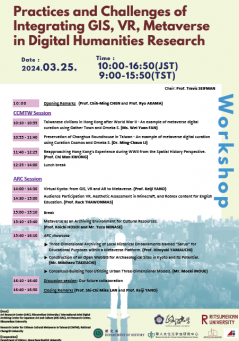
2024年3月25日(月)に、立命館大学アート・リサーチセンター 文部科学省 国際共同利用・共同研究拠点「日本文化資源デジタル・アーカイブ国際共同研究拠点」(ARC-iJAC)と、National Chengchi University, Research Center for Chinese Cultural Metaverse in Taiwan(CCMTW)との国際ワークショップ「Practices and challenges of Integrating GIS, VR, Metaverse in Digital Humanities Research」をハイブリッド開催いたします(本ワークショップは英語で行います)。
日付:2024年3月25日(月)
時間:10:00〜16:50 (JST) / 9:00〜15:50 (TST)プログラムはこちらです。
プログラム
続きを読む>>10:00 Opening Remarks (Prof. Chih-Ming CHEN and Prof. Ryo AKAMA) CCMTW Session 10:10 - 10:55 Taiwanese civilians in Hong Kong after World War II - An example of metaverse digital curation using Gather Town and Omeka S. (Ms. Wei Yuan FAN) 10:55 - 11:40 Preservation of Changhua Roundhouse in Taiwan - An example of metaverse digital curation using Curation Cosmos and Omeka S. (Dr. Ming-Chaun LI) 11:40 - 12:25 Reapproaching Hong Kong's Experience during WWII from the Spatial History Perspective (Prof. Chi Man KWONG) 12:25 - 14:00 Lunch Break ARC Session 14:00 - 14:30 Virtual Kyoto: from GIS, VR and AR to Metaverse. (Prof. Keiji YANO) 14:30 - 15:00 Audience Participation VR, Aesthetic Assessment in Minecraft, and Roblox content for English Education. (Prof. Ruck THAWONMAS) 15:00 - 15:10 Break 15:10 - 15:40 Metaverse as an Archiving Environment for Cultural Resources (Prof. Koichi HOSOI and Mr. Yuzu MINASE) 15:40 - 16:10 ARC Showcase:
→ Three-Dimensional Archiving of Local Historical Embankments Named "Saruo" for Educational Purposes within a Metaverse Platform (Prof. Hiroyuki YAMAUCHI)
→ Construction of an Open WebGIS for Archaeological Sites in Kyoto and Its Potential (Mr. Mikiharu TAKEUCHI)
→ Consensus-Building Tool Utilizing Urban Three-Dimensional Models (Mr. Moeki INOUE)
16:10 - 16:40 Discussion Session: Our future collaboration 16:40 - 16:50 Closing Remarks (Prof. Shi-Chi Mike LAN and Prof. Keiji YANO) 2024年3月23日(土)に、第13回「知識・芸術・文化情報学研究会」を開催いたします。
下記の通り第13回の研究集会の→参加者申し込みを受け付けておりますので、奮ってご参加ください。
またこの会は、ARC-iJACの若手研究者カンファレンスとして位置付けられています。「知識・芸術・文化情報学研究会」詳細:
昨今のデジタル・情報環境の急速な進展とともに、学術分野にも「情報」や「デジタル」を意識した分野横断型の研究が多く見受けられるようになってきました。大学の教育・研究活動においても、この傾向は強まっており、これに関連する教育プログラムやコースの活動が充実しています。
時代に即した新しい研究テーマのもと、このような課程で学ぶ学部生・大学院生や若手研究者が学術的な交流をする機会へのニーズはますます大きくなっています。
そのため、芸術・文化、およびその他の関連する分野の情報・知識研究に興味のある大学院生および若手研究者を主に意識し、発表・交流のための場として「知識・芸術・文化情報学研究会」を2011年度に発足させ、これまで11回の研究集会を開催しました。
本会は、異分野の人的交流を通じて、参加者相互が新たな研究テーマや方法を発見できる場と位置づけており、学会発表とはひと味違う萌芽的・冒険的な発表も歓迎します。開催日:2024年3月23日(土)13:00開始
実施方法:ハイブリッド開催
会場:立命館大学 大阪梅田キャンパス(大阪梅田駅前)、〒530-0018 大阪市北区小松原町2-4 大阪富国生命ビル5階 (https://www.ritsumei.ac.jp/osakaumedacampus/access/)
オンライン:Zoom使用主催:知識・芸術・文化情報学研究会
世話役〔五十音順〕:赤間亮(立命館大学)、阪田真己子(同志社大学)、田窪直規(近畿大学)、村川猛彦(和歌山大学)
共催:情報知識学会関西部会、アート・ドキュメンテーション学会関西地区部会
協力:立命館大学アート・リサーチセンター
文部科学省 国際共同利用・共同研究拠点「日本文化資源デジタル・アーカイブ国際共同研究拠点」■ 参加申し込み方法
続きを読む>>
2024年3月20日(水)までに、参加申し込みフォームよりお申し込みください。
※ 参加費は無料です。
※研究発表会後に懇親会を予定しています(対面のみ)。大学や分野の枠を超えた交流の場にしたいと思いますので、あわせてご参加ください。会場、参加費等は決まり次第ご案内します。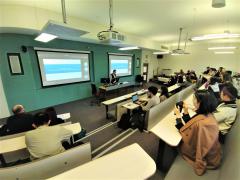
2024年2月20日、立命館大学アート・リサーチセンター文部科学省国際共同利用・共同研究拠点「日本文化資源デジタル・アーカイブ国際共同研究拠点」(ARC-iJAC)とロンドン大学東洋アフリカ研究学院(SOAS)⼈⽂学部は、アート・リサーチセンターセンター長赤間亮教授のロンドン訪問の一環として、デジタルアーカイブ・ワークショップを開催しました。
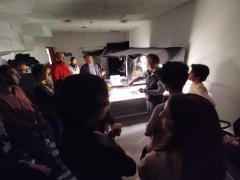
本ワークショップは、立命館大学(RU)、立命館アジア太平洋大学(APU)、ロンドン大学東洋アフリカ研究学院(SOAS)の間で2023年12月に更新された連携協定に基づくもので、デジタル・ヒューマニティーズ(DH)分野における共同研究協力の拡大が盛り込まれています。
本ワークショップには、SOASの教員、図書館職員、学生が参加し、アート・リサーチセンターとそのデジタル・ヒューマニティーズにおけるグローバル研究活動についての紹介に始まり、リーズ大学名誉講師Ellis Tinios氏(ARC客員協力研究員)による「ARCリサーチ・スペースによる古典籍研究の変革」というケーススタディ、赤間センター長による「ARCリサーチ・スペース―日本文化資源の総合的なデジタル・リサーチ・スペースの完成の目指―」というレクチャーが行われました。
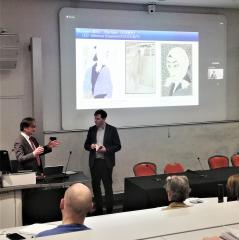
続いて、SOAS図書館が所蔵する浮世絵や日本の古典籍をもとに、赤間センター長が日本の文化資源のデジタル化手法を実演・解説し、参加者は実際にデジタル化を体験しました。
翌日、赤間センター長はSOAS日本研究センター(JRC)主催の「役者絵の終焉: 明治時代の役者絵はどのように消えたのか?」という公開講演も行いました。
2024年3月23日(土)に、第13回「知識・芸術・文化情報学研究会」を開催いたします。
下記の通り第13回の研究集会の→参加者申し込みを受け付けておりますので、奮ってご参加ください。
またこの会は、ARC-iJACの若手研究者カンファレンスとして位置付けられています。「知識・芸術・文化情報学研究会」詳細:
昨今のデジタル・情報環境の急速な進展とともに、学術分野にも「情報」や「デジタル」を意識した分野横断型の研究が多く見受けられるようになってきました。大学の教育・研究活動においても、この傾向は強まっており、これに関連する教育プログラムやコースの活動が充実しています。
時代に即した新しい研究テーマのもと、このような課程で学ぶ学部生・大学院生や若手研究者が学術的な交流をする機会へのニーズはますます大きくなっています。
そのため、芸術・文化、およびその他の関連する分野の情報・知識研究に興味のある大学院生および若手研究者を主に意識し、発表・交流のための場として「知識・芸術・文化情報学研究会」を2011年度に発足させ、これまで11回の研究集会を開催しました。
本会は、異分野の人的交流を通じて、参加者相互が新たな研究テーマや方法を発見できる場と位置づけており、学会発表とはひと味違う萌芽的・冒険的な発表も歓迎します。開催日:2024年3月23日(土)13:00開始
実施方法:ハイブリッド開催
会場:立命館大学 大阪梅田キャンパス(大阪梅田駅前)、〒530-0018 大阪市北区小松原町2-4 大阪富国生命ビル5階 (https://www.ritsumei.ac.jp/osakaumedacampus/access/)
オンライン:Zoom使用主催:知識・芸術・文化情報学研究会
世話役〔五十音順〕:赤間亮(立命館大学)、阪田真己子(同志社大学)、田窪直規(近畿大学)、村川猛彦(和歌山大学)
共催:情報知識学会関西部会、アート・ドキュメンテーション学会関西地区部会
協力:立命館大学アート・リサーチセンター
文部科学省 国際共同利用・共同研究拠点「日本文化資源デジタル・アーカイブ国際共同研究拠点」■ 参加申し込み方法
続きを読む>>
2024年3月20日(水)までに、参加申し込みフォームよりお申し込みください。
※ 参加費は無料です。
※研究発表会後に懇親会を予定しています(対面のみ)。大学や分野の枠を超えた交流の場にしたいと思いますので、あわせてご参加ください。会場、参加費等は決まり次第ご案内します。[イベント情報]2024年2月24日(土)日時:2023年2月23日(金)11:00~17:40、2月24日(土)10:30~17:00(予定)
会場:ハイブリッド開催 ARC+オンライン(ZOOM)(YouTube ライブ配信あり★)主催:立命館大学アート・リサーチセンター、文部科学省 国際共同利用・共同研究拠点「日本文化資源デジタル・アーカイブ国際共同研究拠点」、日本文化デジタル・ヒューマニティーズ拠点「研究拠点形成支援プログラム」
プログラムはこちらです。
[イベント情報]2024年2月23日(金)日時:2023年2月23日(金)11:00~17:40、2月24日(土)10:30~17:00(予定)
会場:ハイブリッド開催 ARC+オンライン(ZOOM)(YouTube ライブ配信あり★)主催:立命館大学アート・リサーチセンター、文部科学省 国際共同利用・共同研究拠点「日本文化資源デジタル・アーカイブ国際共同研究拠点」、日本文化デジタル・ヒューマニティーズ拠点「研究拠点形成支援プログラム」
プログラムはこちらです。



